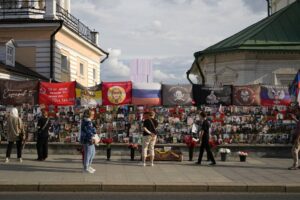People are scared of urban centers. They shouldn’t be.
Three years after the start of the Covid-19 pandemic emptied them, America’s downtowns are still hurting. White-collar workers are only back in their offices about half the time — and far less on Monday or Friday. Many businesses that service those workers have closed up shop. Between 2019 and 2022, office rents in Manhattan fell about 14 percent, according to recent reporting from Axios. In San Francisco, office rents are down by more than twice that.
There’s an obvious explanation for this crisis: Many white-collar workers simply no longer need to commute to their offices, assuming their company even still leases one. But there is another major factor that doesn’t get nearly as much recognition: crime.
“The No. 1 barrier that we heard from people was that fear of crime was what was preventing them from going downtown, particularly within the central business district itself and on their commutes there,” said Hanna Love, senior research associate at the think tank Brookings Institution.
Love is working with a team at Brookings that is studying the health and future of American downtowns. She shared their findings with Today, Explained, Vox’s daily news radio show and podcast, for its new series on the future of cities post-pandemic: “City Limits.” (I’m a producer and reporter for Today, Explained and the lead producer on this series.)
Anyone paying attention to big-city politics right now is probably aware of the salience of crime as an issue. Paul Vallas, one of two candidates in Chicago’s early April mayoral runoff, is running an unabashed law-and-order campaign in a city where car thefts doubled between 2021 and last year. In Philadelphia, 89 percent of respondents to a recent survey ahead of that city’s mayoral election in November said “crime” should be the top priority for elected officials. And in Washington, DC, President Joe Biden recently abandoned his commitment to DC home rule by refusing to veto a Republican measure to block the city’s proposed updated criminal code over concerns that it was soft on crime.
“Things can happen anywhere, anytime,” Allison McDonald, a Chicagoan who lives just outside of downtown, told a Today, Explained freelance producer. “[It] used to feel more pocketed … you kind of knew where to stay away. Now it just happens anywhere, any time of the day. The carjackings. The street crime. It’s just way worse.”
Except here’s the thing: While crime has risen since the pandemic in most US cities, it’s not spiking in downtowns.
Tl;dr: Crime is up, but not up much downtown
That’s what Love and her colleagues found when they crunched the data. She and her team have spent the last few months collecting statistics and conducting about 100 interviews with office workers, small business owners, and other folks in New York, Philadelphia, Seattle, and Chicago — four cities where the downtown business districts have been slow to recover. They then broke out data for violent crime and property crime for each of those cities’ downtowns.
Homicides spiked nationwide in the early part of the pandemic, before leveling off and then declining slightly between 2021 and 2022. Violent crime more broadly — a category that includes rape and aggravated assault — trended up in each city between 2019 and 2022, to varying degrees. Chicago saw a 5 percent increase in violent crime during that time, Philadelphia saw a 1 percent increase, New York saw a 26 percent increase, and Seattle saw a 22 percent increase.
Property crime — a category that includes offenses like larceny and car break-ins — saw a sharper uptick in all four cities. Philadelphia saw city-wide property crime increase by 17 percent, New York 38 percent, Seattle 17 percent, and Chicago 36 percent.
But here’s the twist: in all four of those cities, the share of all property crimes happening downtown remained relatively stable or declined.
Violent crime downtown also stayed relatively stable, declining by 2 percent in Seattle, ticking up by 1 percent in Chicago and Philadelphia, and by 2 percent in New York City.
:no_upscale()/cdn.vox-cdn.com/uploads/chorus_asset/file/24548237/Brookings_figure_4.png)
So downtowns were some of the safest places to be in these cities pre-pandemic. And, by the end of last year, they still were. That fact, though, makes small upticks in crime numbers more perceptible, Love said.
“People aren’t necessarily thinking about citywide statistics when they’re thinking about how they want to feel safe,” Love told Today, Explained co-host Sean Rameswaram. “People are hearing about people getting shot. People are talking to their friends … there is this mismatch in perceptions and reality, but it still matters because people are still afraid.”
Violent crime has long been concentrated in low-income Black and Latino neighborhoods that have also been marked by segregation, discrimination, and disinvestment. But crimes in those areas, Love said, tend to get less media attention than those that occur downtown.
Conflating crime and “disorder”
What else could be behind the mismatch between crime dataand crime vibes? One theory that came up again and again is that city residents and visitors are, to some extent, conflating actual violent crime with broader indications of urban disorder.
“There are several visible signs of disorder that are not necessarily related to crime that are causing people to feel that cities have become unsafe,” Henry Grabar, an urban affairs reporter at Slate, told Rameswaram. “I’m thinking of things like homelessness, drug use, empty streets, and lack of people … that’s causing them to think that cities have become more dangerous places than perhaps they are.”
Homelessness is a good example. In New York, Chicago, and Philly, according to data analyzed by the Brookings team, the homeless population actually fell by more than 20 percent between 2019 and 2022. Seattle was the outlier: King County, which contains Seattle, saw its homeless population grow by 19 percent.
But despite the fact that the homeless population fell by quite a bit in most of those cities during the pandemic, the vast majority of interviewees Brookings spoke to believed the number of homeless people in their city had spiked and that the unhoused were contributing to the crime problem.
“Across the board, the visibility of unsheltered homelessness has increased in downtowns because there’s less street activity. So people are seeing or noticing more unsheltered people and they are feeling unsafe because of that,” Love said. “That doesn’t necessarily line up with what the statistics tell us, which is that people who are experiencing homelessness are more likely to be victims of crime than to perpetrate them.”
Tackling the perception of crime downtown
So what can a mayor or other elected official do to make people feel as safe as they actually are downtown?
Tackling this perception was the explicit goal of “Broken Windows”-style policing. The strategy, laid out in a 1982 Atlantic essay and adopted most prominently by New York City in the 1990s, argued that police should aggressively enforce low-level offenses like public urination and graffiti, both because that type of crime makes people afraid and because it creates a sense of impunity where more serious crime can flourish.
Broken Windows may have made some people feel safer, but, through its cornerstone policy of stop-and-frisk, it also led to countless Black and Latino city residents being targeted by police in dehumanizing and legally dubious stops. In Philadelphia in 2009, police made more than 260,000 stops, more than any other police department in the country, according to an American Civil Liberties Union report. Close to half of those stops were made without showing any reasonable suspicion.
And the actual impact of the Broken Windows policy on crime is still debated. Serious crimes fell in New York City throughout the 2000s — and kept falling after NYC’s stop-and-frisk policy was declared unconstitutional in 2013.
Grabar argues that the best way to address the perception problem is to get more bodies back into downtown on a regular basis. It’s a notion first articulated as “Eyes on the Street” by the famous urbanist Jane Jacobs: the idea being that healthy communities naturally enforce shared social norms. But that requires numbers.
And therein lies the problem. People don’t want to go downtown because they’re worried. But the best way to make people feel safe again downtown … is to have more people there. The best way to square that circle, Grabar suggests, is that downtowns should try and attract residents instead. That means converting offices to residences and building new housing.
City leaders in New York and Chicago are on board: They’re pushing plans to encourage office-to-residential conversion. And in Seattle, the planning department is offering a $10,000 prize to teams of property owners and designers that submit plans to convert downtown office buildings to residences.
“I don’t think I’m telling city leaders anything they don’t know. It’s just that I don’t think they quite grasp the urgency of it, because if you don’t get people downtown, if you don’t make those streets feel full and lively and vibrant again, then people will leave and they will stop coming,” Grabar said. “And then you get this sort of doom loop of empty streets and a feeling of insecurity and disinvestment in public services and so on. So adding housing downtown is a big way of bringing people back and making the streets feel safe.”
The renaissance in American cities that began in the 1990s and lasted up until the pandemic arrived depended on bringing crime down and making people feel safer. The challenge for city leaders in this remote-work era is to once again find success on both of these fronts, but without resorting to the punitive tactics of their forebears.
Source: VOX News









